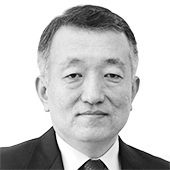Paying more to get more is just a scam

Koh Hyun-kohn
The author is the executive editor of the JoongAng Ilbo.
To appear to have the upper hand in the field can be a winning strategy. Opposition Democratic Party (DP) leader Lee Jae-myung’s sudden proposal of settling the national pension reform by compromising with the governing party’s 44 percent idea in income replacement rate last month changed the game on outlining the overhaul in the reform. His gesture of engagement postured the opposition party to take the initiative in pension reform as opposed to the stalling and backtracking government and the People Power Party (PPP). The accountability for the delay in the reform will now fall on the governing conservative front. Yet the government and the PPP appear to be oblivious to their losing prospects.
The DP leader did not have any interest in the pension reform. He made little mention of it during the last presidential campaign, and none of the DP members raised the issue over the last two years. But Lee took center stage with just one strike, again proving his ability to score points on the political field.
What Lee proposed was an outline to raise the contribution rate from 9 percent to 13 percent and increase the income replacement rate to 44 percent from 40 percent. Kim Jin-pyo, a DP member chairing the 21st National Assembly before it expired in May, seconded the move by suggesting an ad hoc session to pass at least the core revision to the National Pension Act. Pension experts, some members of the PPP, and the media supported the move to pave the way for the long-delayed pension reform. The outline suddenly became the best option in pension reform, and is likely to become a major issue in the 22nd National Assembly.
Proponents find meaning in lifting the premium rate stuck at nine percent for 26 years to 13 percent, but neglect the downside of raising the replacement rate to 44 percent. The rise in the payout rate offsets the effect of a higher contribution rate. There is no meaning in the reform if it is revamped to pay more to get more. It is a trick to rip off the future generation.
At the current rate, the fund will be depleted by 2055. Those born after 1990 may end up getting nothing when they reach old age. Under the scenario of charging 13 percent for a return of 44 percent, the national pension will run out of money in 2064. Earning just nine years before the fund is depleted cannot be any relief. The reform should be done to ensure that the fund stays sustainable. Under the latest projection in the pension finance, the premium rate should be elevated to 19.8 percent and the income replacement rate frozen at 40 percent to not victimize future generations.
Pension shortfall is a global challenge for countries facing the common phenomenon of an aging and thinning population due to a low birthrate. Many are restructuring their public pension system to “pay more and get less” by increasing the contribution or decreasing the benefit. They are also stretching the contribution period or delaying the starting age for receiving pension. There are no countries opting for a higher payout rate for the reform. The replacement rate in the contribution-based pension was designed to be lowered to 40 percent by 2028 from the initial 70 percent across 40 years. Former President Roh Moo-hyun opposed the idea of lowering the replacement rate while he was a candidate in 2002, but then changed his mind while in office. He pushed for the replacement target to be lowered to 40 percent despite strong opposition. The country experiencing the fastest aging and lowest birthrate could be ridiculed by other countries if it chooses to lift the replacement rate to 44 percent.
While the DP is driving the ball towards the wrong goal, the government and the PPP are chasing the ball without attempting to steer it away. Their sole interception idea is to correlate the fixes with other pension schemes. The sudden idea of structural reform can only appear as foul play to the audience. A structural reform cannot be realistic with just three years left in the current administration.
The government and the PPP are stumbling because they lack a clear strategy and objective. Whether they have the will to reform is also doubtful. They must make their stand to oppose the raise in the income replacement rate instead of trying to buy time through the structural reform idea. They must call for an increase in the premium rate to 13 percent and fix the replacement rate at 40 percent. Further on, the premium rate must go up higher and the income replacement rate lower. Japan’s premium rate is 18.3 percent and its replacement rate is 33 percent. The Japanese contribute twice more than Koreans and get less to sustain their public pension for 100 years.
Nobody can be happy about contributing more and getting less. Politicians are merely counting immediate votes. Pension reform is an unpopular policy as President Yoon Suk Yeol admitted. The government must propose to raise the premium rate and lower the replacement rate. If the opposition accepts the sustainable outline, Lee’s sincerity behind the pension reform will be recognized. A leader who cares for the country’s future must have guts. The deficit must not land on future generations. There should be no disagreement between conservatives and liberals on this goal.










with the Korea JoongAng Daily
To write comments, please log in to one of the accounts.
Standards Board Policy (0/250자)